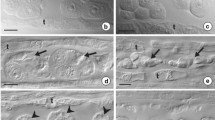Abstract
The anther wall ofC. koenigii showed the epidermis, endothecium, middle layer and tapetum. Cytokinesis in the pollen mother cells was successive and isobilateral type of tetrads were formed. The mature pollen grains were three-celled. The development of the embryo sac conformed to the Polygonum type. The antipodal cells increased in number and persisted in the young fruit. Twin embryo sacs occurred in about 30% of the ovules. Endosperm development was nuclear.
Similar content being viewed by others
References
Brown W V and Emery W H P 1958 Apomixis in the Gramineae: Panicoideae;Am. J. Bot. 45 253–263
Chandra N 1963 Some ovule characters in the systematics of Gramineae;Curr. Sci. 32 277–279
Chikkannaih P S and Mahalingappa M S 1975 Antipodal cells in some members of Gramineae;Curr. Sci. 44 22–23
Davis G L 1966The systematic embryology of angiosperms (New York: John Wiley)
Esau K 1974Plant anatomy edn (New delhi; Wiley Eastern)
Farquharson L J 1955 Apomixis and polyembryony inTripsacum dactyloides;Am. J. Bot. 42 737–743
Khosla S 1946 Developmental morphology in some Indian millets;Proc. Indian Acad. Sci. B24 207–224
Koul A D 1959 Antipodals during development of caryopsis inEuchlaena mexicana;Agra Univ. J. Res. 8 31–33
Muniyamma M 1976 A cytoembryological study ofAgrostis pilosula;Can. J. Bot. 41 1077–1079
Narayanaswami S 1953 The structure and development of the caryopsis in some Indian millets 1.Pennisetum typhoideum;Phytomorphology 3 98–112
Narayanaswami S 1954 The structure and development of the caryopsis in some Indian millets 2.Paspalum scrobiculatum;Bull. Torrey Bot. Club 81 288–299
Narayanaswami S 1955a The structure and development of the caryopsis in some Indian milletts 3.Panicum miliare andP. miliaceum;Lloydia 18 61–73
Narayanaswami S 1955b The structure and development of the caryopsis in some Indian millets 4.Echinochloa frumentacea;Phytomorphology 6 161–171
Narayanaswami S 1956 The structure and development of the caryopsis in some Indian milletts 6.Setaria italica;Bot. Gaz. 118 112–122
Randolph L F 1936 Developmental morphology of caryopsis in maize;J. Agric. Res. 53 881–916
Shantamma C 1979 Reproductive behaviour ofpennisetum macrostachyum and new basic chromosome number in the genusPennisetum;Bull. Torrey Bot. Club 106 73–78
Swamy B G L 1944 A reinvestigation of the embryo sac ofEragrostis cilianensis;Curr. Sci. 13 103–104
Weatherwax P 1926 Persistence of antipodal tissue in the development of seed of maize;Bull. Torrey Bot. Club 53 381–384
Author information
Authors and Affiliations
Rights and permissions
About this article
Cite this article
Satyamurty, T.V.C. Development of the caryopsis inChionachne koenigii Linn.. Proc. Indian Acad. Sci. 93, 567–570 (1984). https://doi.org/10.1007/BF03053219
Received:
Revised:
Issue Date:
DOI: https://doi.org/10.1007/BF03053219




